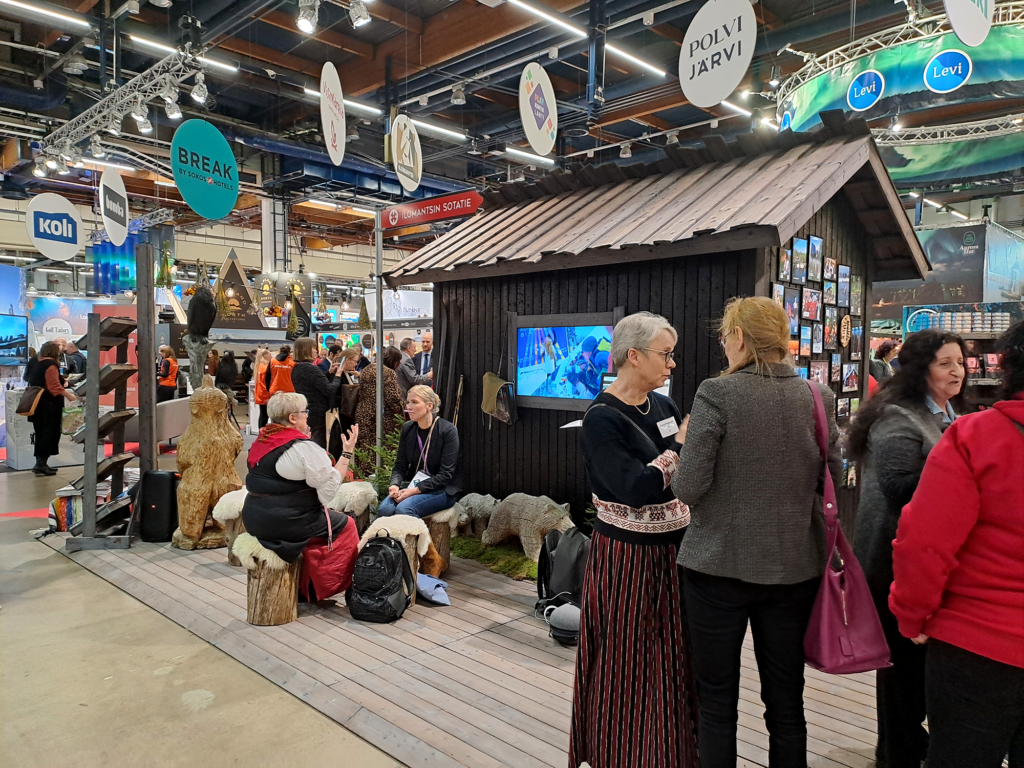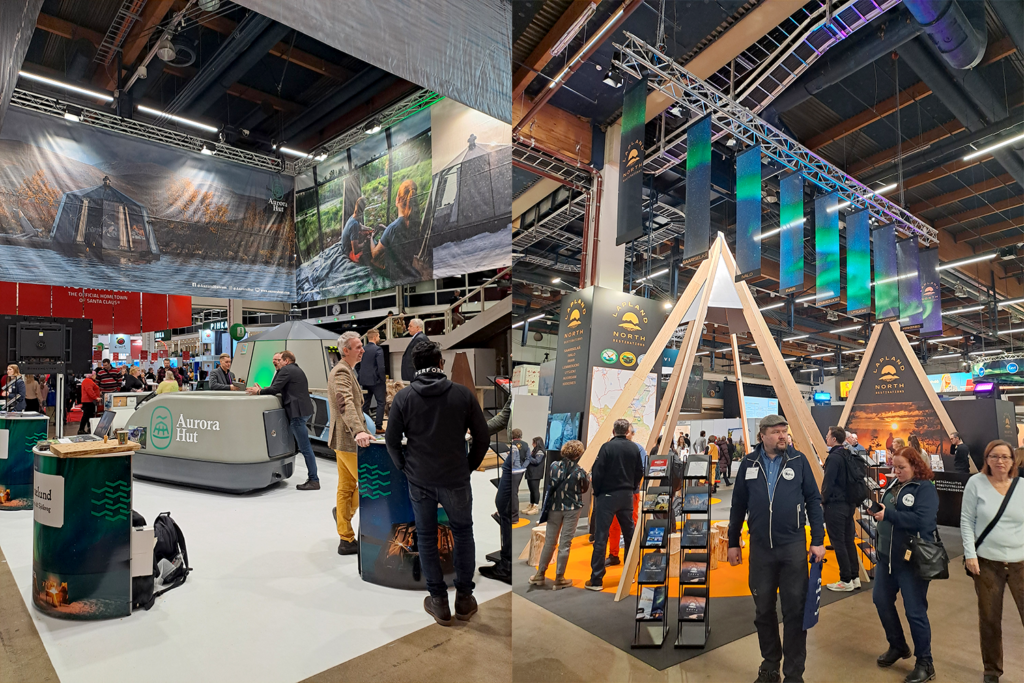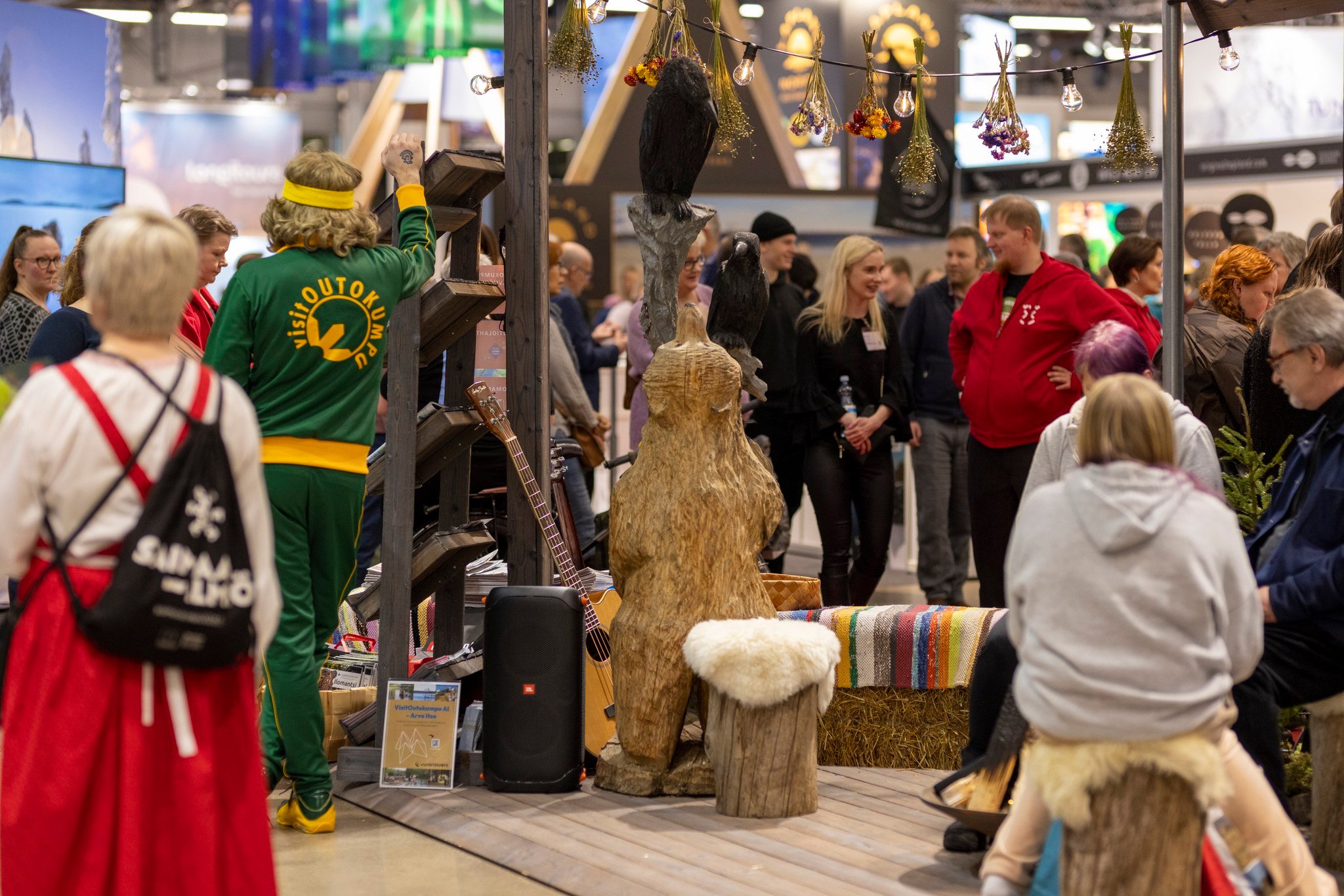GLOW2.0’s Finnish partner Karelia UAS’ representatives attended the Matka 2024 Travel Fair in Helsinki on January 18th. The aim was to gain up-to-date knowledge of tourism industry, present the project and explore different ways to make tourism entrepreneurs and travellers more aware of the opportunities of the dark skies and new technologies. The trip proved to be successful: both old and new connections with stakeholders were fortified and benchmarking showed that there is indeed a market niche for dark skies related tourism offerings in Northern Europe.
During the fair the newest tourism related research is showcased and discussed in Matkatieto conference organised by the Association of Finnish Travel Industry. Conference topics discussed this year e.g. utilising AI in tourism, how tourists’ values and attitudes differentiate in Finland, and responsible tourism. This article will focus on Dark Skies Tourism related viewpoints on responsible tourism as learned from the conference.
Matka 2024 gathered over 50.000 participants
Matka Travel Fair 17.-21.1.2024 in Helsinki is Northern Europe’s largest travel industry event. This year the event was visited by over 50.000 consumers and 13.000 travel trade professionals from approximately 70 different countries (Messukeskus 2024). For tourism professionals Matka Travel Fair offers opportunities to develop business and new skills, network and encounter both peers and clients. Besides travel agencies, international DMOs and tour operators, several regions of Finland are also presented in the fair to promote tourism. This includes NPA areas such as North Karelia, Kainuu and different regions and organisations from Finnish Lapland.
One of the aims of our trip to Matka 2024 was to explore how dark skies are utilized in tourism marketing images worldwide. We discovered that, aside from the common northern lights imagery in Northern European destinations, darkness is not widely used in marketing. We concluded that darkness may not yet be seen as a competitive factor in tourism, even though many national parks also in NPA areas have naturally unlit, light pollution-free zones.

Responsible tourism was in emphasis in the Matkatieto conference
At the fair, responsible tourism was the focus of the Matkatieto conference. In the past, tourism was about sustainability, focusing on ensuring that the tourists’ footprint in the destination was as small or as invisible as possible. For example, hiking trail guides advised people to leave only their own footprints in nature. Earlier attention was also paid to emissions. Now the term regenerative tourism has been introduced, which means that it is no longer enough to minimise the tourist footprint or to leave no footprint at all. The aim now is to make the destination more intact after the tourist has left. This is where communication matters: how do you involve the tourist in improving the destination or area? The answer can be found in responsible communication.
Responsible communication is tourism marketing that communicates sustainable solutions in a factual and truthful way. Since it is marketing, the communication must be targeted. It is therefore important to know and identify to whom the communication is aimed at. Different target groups have different perceptions of sustainability and use different concepts and words.
Responsibility communication includes, for example, so-called nudging. This means that a company can influence customer choices through its own communications and actions. For example, an accommodation company may not provide daily cleaning of rooms unless requested to do so. A restaurant may ask you to take only as much food at the breakfast buffet as you need or guide your choices by using smaller plate sizes. These actions can then be communicated openly and at the same time encourage customers to act in a sustainable way. (Dolnicar 2020.) Communication can also be used to persuade tourists to act in favour of a destination or region. For example, a tourist can contribute to the upkeep of a company’s grounds by pulling out invasive plant species or collecting rubbish. This is a simple and easy example of regenerative tourism.
Responsible communication in the context of Dark Sky Tourism can mean informing your customers that you are reducing light pollution by redirecting and scaling down unnecessary outdoors lighting in your company’s environment, while actually improving the environment’s safety and attractiveness. DMOs and municipalities can encourage both locals and entrepreneurs to reduce unnecessary lighting by providing guidance on how to direct lights to reduce light pollution. Nudging, on the other hand, would mean explaining how light affects animals and plants. It is also worth pointing out the positive effects of darkness on human well-being.

A compelling message guides towards more environmentally friendly decisions
In addition to responsible and regenerative tourism, The Matkatieto 2024 conference focused on how we could encourage customers to make responsible decisions. A study that tested how to influence customers’ travel booking decisions found that changes in the decision-making situation could promote more environmentally friendly choices (Cvelbar, Grün & Dolnicar 2017). Video material shown at the time of booking, which aroused feelings of empathy for the environment and future generations, led to the choice of more environmentally friendly travel options. Evoking sad feelings, on the other hand, did not lead to more environmentally friendly choices. Based on this finding, it seems to be worthwhile to evoke positive feelings towards the environment. What, then, could increase eco-friendly behaviour?
Social pressure increases environmentally friendly behaviour (Dolnicar, Knezevic Cvelbar & Grün 2019). Appealing to the behaviour of others in the same situation has been found to work quite well, even if customers do not directly benefit from changing their behaviour. Comparison with other people who are or have been in a similar situation is more effective than any desire to identify as an environmentally conscious person in general. Environmentally friendly behaviour can also be encouraged by reminding that by choosing an environmentally friendly option and avoiding disposable solutions you can increase the well-being of your loved ones and future generations.
In order for responsible tourism to become mainstream tourism, the message should be targeted specifically at those tourists who have not previously paid attention to sustainability issues. Messages describing the activities in concrete terms work better than general ones (e.g. 75% of those staying at this hotel use a towel again). At the Matkatieto conference, researcher Katja Pasanen highlighted the classic methods of rhetoric that can be used to influence customers. These were:
- Ethos (credibility/character of the speaker)
- pathos (appeal to emotions) and
- logos (rational arguments/appeal to reason)
When these are balanced, the message is impressive. In this case, the message provider gives a reliable image of themselves, and the message is received positively. The message appeals to emotions and, at the same time, can be justified by reason. At best, the message will make the recipient change their behaviour in a more responsible direction. (Pasanen, Konu & Koponen 2023.)
In the communication of tourism in the unlit sky, you can highlight the benefits of darkness. In marketing communications, environmentally conscious people can be told with examples of the benefits of twilight and darkness for nature, its animals and plants. For those who care about their health, the company can emphasize the benefits of darkness for their own well-being. In this way, the company not only markets its own services that exploit darkness and justifies its own possible solutions to reduce lighting, but also disseminates information about the benefits of darkness. Thus, the responsibility of corporate communication has several dimensions.
Authors:
Tarja Kupiainen, Principal Lecturer, Karelia UAS
Outi Santaniemi, Project Specialist, Karelia UAS
Sources:
Cvelbar, L. K., Grün, B. & Dolnicar, S. 2017. Which hotel guest segments reuse towels? Selling sustainable tourism services through target marketing, Journal of Sustainable Tourism, 25(7), 921-934. https://doi.org/10.1080/09669582.2016.1206553
Dolnicar, S. 2020. Designing for more environmentally friendly tourism. Annals of Tourism Research, 84:102933. https://doi.org/10.1016/j.annals.2020.102933
Dolnicar, S, Knezevic Cvelbar, L. & Grün, B. 2019. A Sharing-Based Approach to Enticing Tourists to Behave More Environmentally Friendly. Journal of Travel Research 58(2), 241-252. https://doi.org/10.1177/0047287517746
Messukeskus. 22.1.2024. Matka Travel Fair brought holiday dreams to the forefront. Tiedote. https://www.messukeskus.com/en/news/matka-travel-fair-brought-holiday-dreams-to-the-forefront/ Luettu 24.1.2024.
Pasanen, K., Konu, H. & Koponen, J. 2023. Matkailuyrityksen vakuuttava vastuullisuusviestintä – millaiset retoriset keinot ja vastuullisuussisällöt vetoavat suomalaisiin kuluttajiin? https://doi.org/10.33351/mt.125275
Cover Photo: Anna Autio / Messukeskus

